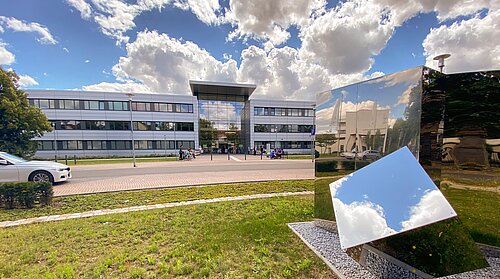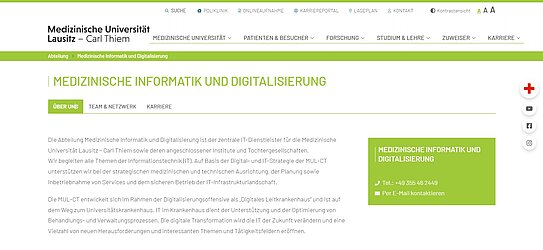Significantly improved information quality thanks to BCS
User report from Medizinische Universität Lausitz – Carl Thiem
Projektron BCS is a tool in which all participants can access all information simultaneously and in real time in the latest version - the place where everything comes together. In BCS we can easily map our entire internal organization, implement resource planning and material cost planning holistically across projects.
Interface between the scientific and healthcare systems: Medical University of Lausitz – Carl Thiem
With 1,200 beds, over 100,000 patients per year and around 3,000 employees and trainees, the Medical University of Lausitz – Carl Thiem is not only the largest employer in Cottbus and the largest hospital in the state of Brandenburg, but also one of the largest and most efficient hospitals in the whole of Germany.
With more than 20 clinics, departments and sections, the Medical University of Lausitz – Carl Thiem is a high-performance medical center.
The Medical University of Lausitz – Carl Thiem is an institution of the state of Brandenburg, founded in Cottbus on July 1, 2024. It organizes research, teaching and patient care in an integrated model in a legal and organizational unit under joint management. In addition, the Medical University will take on tasks at the interface between the scientific and healthcare systems. The medical care part of the Medical University has emerged from the Carl Thiem Clinic in Cottbus.
The MUL-CT is developing as a “digital lead hospital” as part of the digitization offensive. The digital transformation serves to optimize treatment and administrative processes.
Strategic digitization projects with Projektron BCS
The central task of the former Department of Digitalization & Innovation at the Carl Thiem Clinic and the current Directorate of Finance, IT & Digitalization at the Medical University of Lausitz - Carl Thiem is the successful implementation of strategic digitalization projects. Among other things, our department is responsible for strategic project portfolio management, project management for strategic digitalization projects and the development of new data infrastructures as a basis for research access to medical and procedural care data in the region.
As part of the Hospital Future Act (KHZG), the federal government also sets out specific requirements for various types of funding in the form of “mandatory criteria”, which we must meet as part of our digitalization projects by the end of 2024. The mandatory criteria include online appointment booking, the option of taking a digital medical history from home, document uploads (e.g. medication plan) by the patient before their stay, access options to the data stored in the ePA, structured data exchange between service providers and interfaces to support downstream processes, such as searching for free places with care and rehabilitation providers.
We establish and develop skills in how to set up and design a project organization in the healthcare sector - an aspect with which hospitals have had few points of contact to date and, accordingly, have had little experience. Now, however, this need exists to a great extent. We also see it as our task to develop these skills and methods locally. Digitization necessarily changes processes and creates new complexity. In order to be able to map this complexity and processes adequately, we absolutely need a suitable tool that all those involved can use easily and in a goal-oriented manner.
Only with centralized software, in which we can map all these processes and topics in addition to our line activities in IT and collect and distribute information, can this variety and abundance of complex tasks be managed. Since April 2021, we have therefore been relying entirely on Projektron BCS in the former Digitalization & Innovation department. This is where we plan our strategic digitalization projects holistically and ensure a continuous flow of information.
BCS is a tool in which all participants can access all information simultaneously and in real time in the respective current version - the place where everything flows together. There are no disputes about the validity of Excel plans and no communication problems due to outdated versions. In BCS, we can easily map our entire internal organization, implement resource planning and material cost planning holistically across projects.
Transformation in the healthcare sector - BCS as a factor
Project organization is an issue across all sectors. This applies not only to our overarching healthcare sector in general, but also to the subordinate areas of IT, digitalization & innovation, and research in equal measure. We all rely on structured ways of working. Tools we use to structure our ways of working need to align with the way we can also map our work internally - be it via Kanban or personal task allocation via tickets or automated workflows. Projektron BCS holds all these possibilities and allows me to ideally mirror my organization in its individual way of working and to support it in its communication in the best possible way.
Around 20 project managers who are responsible for projects in the three core areas of IT, digitalization & innovation and research are actively involved in BCS use, as they draw on some of the same resources to carry out their projects. For our major projects, we also use the PRINCE2 project management method as far as it fits the organization in the individual case, which BCS supports optimally with functionalities and corresponding assistants.
The internal organization and project management are left to each department. In our department, we have established a Transformation Office in the sense of agile project management, in which we meet fortnightly to discuss the progress of the project. In this way, we strengthen the flow of information and shorten project runtimes, because we don't have to consult a steering committee for every decision.
The management only needs to be involved in cases where the Transformation Office no longer has any decision-making authority on its own with regard to an issue (out of budget, scope change, etc.).
Multi-project management and resource planning with BCS
I have found Projektron BCS to be a flexible and methodically supportive tool. The wizards, for example, are methodically supportive, guiding project managers through various processes and pointing out where action is needed.
One of our core requirements for project management software was the aspect of multi-project management. We need to be able to see whether a resource is involved in both a project from our IT department and, at the same time, in a project from the research department. Only in this way is it possible to plan an economically sensible utilization of resources without overloading.
Resources, especially in the technical environment, are limited. Different stakeholders and different activities are involved here: In addition to line activities in IT, strategic projects arise, but they rely on the same resources. This makes prioritization necessary. If certain resources are not available, BCS actively supports the assessment of which activities are important and which activities are urgent and facilitates the necessary reprioritization.
When planning and managing numerous simultaneous projects, resource management is naturally a constant task. A practical feature of BCS is that vacation dates, working time models and other absence dates stored there directly contribute to resource planning. BCS is also indispensable for the financial control of projects and the planning of material costs.
As a municipal institution, we are also dependent on integrating external stakeholders into the platform and having them participate and contribute to projects and their implementation in various ways. BCS offers the ideal conditions for this, as external project participants can also be involved without any problems and everyone receives the information they need.
Since we also include our financial accounting in our project management and planning activities, we will in future be looking even more closely at the options for cost objects and cost types in BCS in order to be able to communicate planned calls for funds and budget planning even more transparently and directly internally.
Conclusion: Quality over Demand
We have come to know BCS as an enormously useful tool. This includes not only the mere functionality, but also the quality of the service. When deciding for or against a software, it is all too easy to neglect this - in my opinion decisive - aspect.
When things really have to move quickly, we have always been able to rely on Projektron GmbH.
Two examples:
| 1. | A few weeks ago, we needed a total invoice receipt column in the portfolio overview. After our request to Projektron support, the column was set up and ready to use in less than 24 hours. In my view, this is a decisive difference compared to open source solutions and many other tool providers on the market. |
| 2. | Updates to protect us from critical security vulnerabilities, such as Log4J, had already been installed by Projektron GmbH before we could even bring them to their attention. |
What also impresses us is the release stability and transparency of Projektron BCS itself. We always have the feeling that we are transparently informed about product development - whether via the website, the newsletter or the release events in the fixed quarterly release cycle.
One visit to the website and you can see immediately:
- What is planned for the next release?
- What has been released recently?
- What is already available, but maybe I don't use it yet?
Because of this transparency and reliability, Projektron's product development deserves great praise. We have already had three training courses carried out in-house, the content of which was individually tailored by Projektron GmbH to our requirements and needs. We are also very satisfied with their implementation and the individual consulting.
The qualitative result of our BCS usage: We have a much better quality of information. The provision of relevant information to all project participants is now a bring responsibility of the project managers. Our goal is for all projects, including their relevant control and resource information, to be reflected in Projektron BCS.










